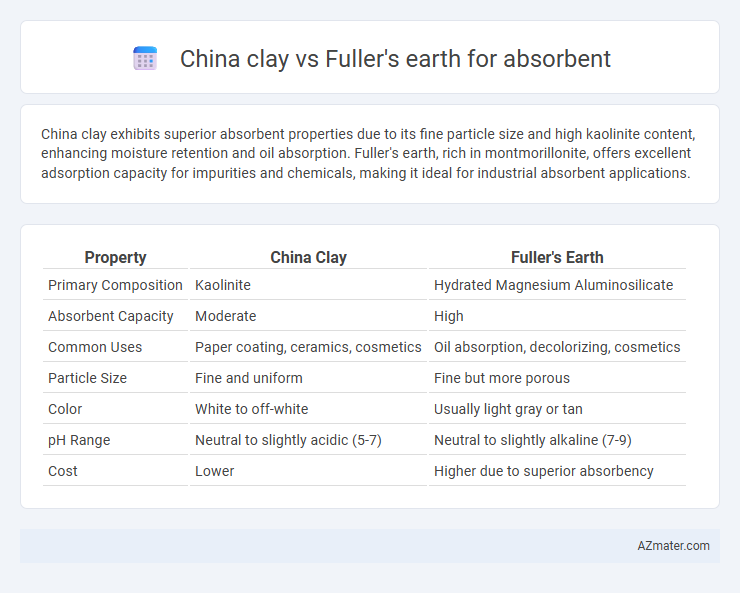China clay exhibits superior absorbent properties due to its fine particle size and high kaolinite content, enhancing moisture retention and oil absorption. Fuller's earth, rich in montmorillonite, offers excellent adsorption capacity for impurities and chemicals, making it ideal for industrial absorbent applications.
Table of Comparison
| Property | China Clay | Fuller's Earth |
|---|---|---|
| Primary Composition | Kaolinite | Hydrated Magnesium Aluminosilicate |
| Absorbent Capacity | Moderate | High |
| Common Uses | Paper coating, ceramics, cosmetics | Oil absorption, decolorizing, cosmetics |
| Particle Size | Fine and uniform | Fine but more porous |
| Color | White to off-white | Usually light gray or tan |
| pH Range | Neutral to slightly acidic (5-7) | Neutral to slightly alkaline (7-9) |
| Cost | Lower | Higher due to superior absorbency |
Introduction to China Clay and Fuller’s Earth
China clay, also known as kaolin, is a fine, white clay mineral primarily composed of kaolinite, renowned for its excellent absorbent properties and wide industrial applications. Fuller's earth is a natural clay material rich in hydrous aluminum silicates, valued for its superior oil and grease absorption capabilities in various cleaning and cosmetic uses. Both materials exhibit high adsorption capacities, but China clay is often preferred for its purity and consistency, while Fuller's earth is favored for tougher contaminant removal due to its more porous structure.
Origins and Composition: China Clay vs Fuller’s Earth
China clay, primarily composed of kaolinite, originates from the decomposition of feldspar-rich rocks and is extensively mined in regions like Cornwall, England, and parts of China. Fuller's earth consists of various clay minerals including montmorillonite, bentonite, and palygorskite, formed through the weathering of volcanic ash or sedimentary deposits in areas such as the United States, India, and Turkey. The distinct mineral compositions influence their absorbent properties, with China clay offering fine, white particles ideal for bleaching and filtration, while Fuller's earth demonstrates higher oil absorption and detoxifying capabilities.
Key Absorbent Properties Compared
China clay, also known as kaolin, exhibits high whiteness, fine particle size, and moderate absorbency, making it suitable for cosmetics and paper coatings. Fuller's earth demonstrates superior oil and grease absorption due to its higher porosity and larger surface area, commonly used in industrial and environmental applications. The key absorbent properties comparing both include specific surface area, pore volume, and chemical composition, with Fuller's earth providing enhanced oil absorption while China clay offers better purity and brightness.
Industrial Applications in Absorption
China clay, also known as kaolin, exhibits moderate absorbent properties primarily useful in paper coating and ceramics, while Fuller's earth demonstrates superior absorption capacity for oils, greases, and impurities, making it highly effective in industrial cleaning, refining, and filtration processes. In industrial applications, Fuller's earth is preferred for its ability to adsorb petroleum products, heavy metals, and toxins, enhancing the quality of lubricants, cosmetics, and wastewater treatment. The distinct mineral compositions of these clays determine their absorption efficiency, with Fuller's earth's high porosity and surface area making it more versatile in industrial absorption tasks.
Efficiency in Oil and Grease Removal
China clay, primarily composed of kaolinite, offers moderate absorbency for oil and grease but excels in applications requiring fine particle size and whiteness. Fuller's earth contains a higher percentage of montmorillonite and bentonite, providing superior adsorption capacity and efficiency in oil and grease removal due to its swelling properties and larger surface area. Industrial processes favor Fuller's earth over China clay when maximum absorbent performance is crucial for environmental remediation and oil spill cleanups.
Performance in Environmental Cleanup
China clay exhibits high absorptive capacity due to its fine particle size and high water retention, making it effective in oil spill remediation and heavy metal adsorption. Fuller's earth, rich in montmorillonite and other clay minerals, demonstrates superior adsorption efficiency for organic pollutants and grease, enhancing its performance in environmental cleanup. Both materials are environmentally benign, but Fuller's earth often outperforms China clay in treating contaminated water by binding a wider range of pollutants.
Cost and Availability Analysis
China clay and Fuller's earth are both widely used absorbents with distinct cost and availability profiles. China clay, more abundant and extensively mined globally, generally offers lower costs due to large-scale production and established supply chains. Fuller's earth can be costlier and less readily available in some regions, limiting its widespread use despite its superior oil and grease absorption capabilities in industrial applications.
Environmental Impact and Sustainability
China clay, primarily composed of kaolinite, offers high absorbency with minimal environmental impact due to its natural abundance and low chemical processing requirements. Fuller's earth, rich in montmorillonite or attapulgite, demonstrates superior oil and heavy metal absorbency but involves more intensive mining processes that may disrupt ecosystems. Sustainable sourcing practices and rehabilitation of mining sites are critical for mitigating the environmental footprint of both materials in industrial applications.
User Safety and Handling Concerns
China clay, primarily composed of kaolinite, offers excellent absorbent properties with minimal dust generation, enhancing user safety during handling. Fuller's earth, containing a mix of minerals like montmorillonite, is highly absorbent but tends to produce more airborne particles, posing inhalation risks if proper protective equipment is not used. Both materials require controlled environments and appropriate personal protective equipment to mitigate respiratory hazards and skin irritation for safe handling.
Which Absorbent to Choose: Final Recommendations
China clay and Fuller's earth both offer excellent absorbent properties, but Fuller's earth typically provides superior oil and grease absorption due to its higher porosity and stronger adsorptive capacity. For industrial applications requiring heavy-duty pollutant removal, Fuller's earth is the optimal choice, whereas China clay is preferred for cosmetic and pharmaceutical uses due to its finer texture and gentler absorbency. Choose Fuller's earth when prioritizing maximum contaminant retention, and opt for China clay when purity and mild absorbency are essential.

Infographic: China clay vs Fuller’s earth for Absorbent
 azmater.com
azmater.com